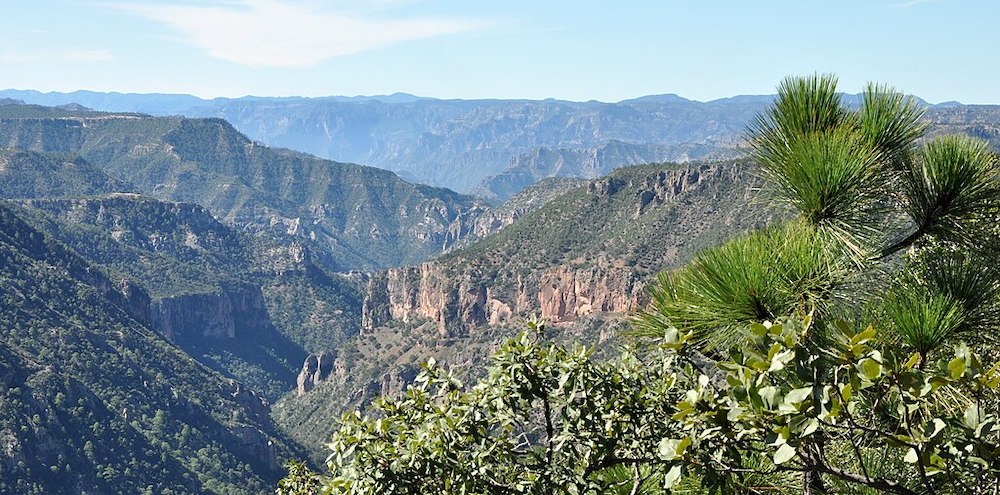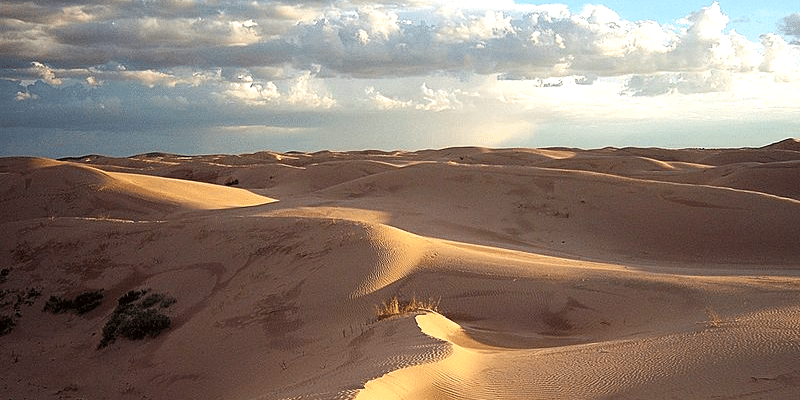Free and Sovereign State of Chihuahua

Chihuahua is a landlocked state, one of the 31 states which, along with Mexico City, comprise the 32 federal entities of Mexico. It is the largest Mexican state covering over 247,000 km2 (almost 100,000 square miles) , meaning it is slightly larger than the United Kingdom, with a population of about 3.75 million. It is consequently known under the nickname El Estado Grande. It is located in the northwestern part of Mexico and is bordered by the states of Sonora to the west, Sinaloa to the southwest, Durango to the south, and Coahuila to the east. To the north and northeast, it shares an extensive border with the US. adjacent to the US states of New Mexico and Texas. The state was named after its capital city, Chihuahua City; however, the largest city, with a population of c. 1.6 million people is Ciudad Juárez.
Although Chihuahua is primarily identified with its namesake, the Chihuahuan Desert, it has more forests than any other state in Mexico, aside from Durango. Due to its varied climate, the state has a large variety of fauna and flora. It is mostly characterised by rugged mountainous terrain and wide river valleys. The Sierra Madre Occidental mountain range, part of the continental spine that also includes the Rocky Mountains, dominates the state’s terrain.
On the slope of the Sierra Madre Occidental mountains there are vast prairies of short yellow grass, the source of the bulk of the state’s agricultural production. Most of the inhabitants live along the Rio Grande Valley, and the Conchos River Valley.
The state is made up of three geologic regions: Mountains, Plains-Valleys, and Desert, which occur in large bands from west to east. Because of the different geologic regions there are contrasting climates and ecosystems.

Sierra Madre Occidental – ©Cataclasite CC BY-SA 3.0 via Wikimedia Commons
The main mountain range in the state is the Sierra Madre Occidental reaching a maximum altitude of nearly 11,000 ft known as Cerro Mohinora. Mountains account for one third of the state’s surface area which include large coniferous forests. Chihuahua has more forests than any other state in Mexico making the area a bountiful source of wood; the mountainous areas are rich in minerals important to Mexico’s mining industry. The climate in the mountainous regions varies. Precipitation and temperature in the mountainous areas depends on the elevation. Between the months of November and March snow storms are possible in the lower elevations and are frequent in the higher elevations. There are several watersheds located in the Sierra Madre Occidental all of the water that flows through the state; most of the rivers finally empty into the Río Grande. Temperatures in some canyons in the state reach over 38 °C in the summer while the same areas rarely drop below 0 °C in the winter. Microclimates found in the heart of the Sierra Madre Occidental in the state could be considered tropical, and wild tropical plants have been found in some canyons.
La Barranca del Cobre, or Copper Canyon, is a spectacular canyon system larger and deeper than the Grand Canyon; the canyon also contains Mexico’s two tallest waterfalls: Basaseachic Falls and Piedra Volada. There are two national parks in the mountainous area: Cumbres de Majalca National Park and Basaseachic Falls National Park.
The plains at the foot of the Sierra Madre Occidental is an elongated mesa known as Altiplanicie Mexicana that exhibits a steppe climate and serves as a transition zone from the mountain climate in the western part of the state to the desert climate in the eastern side of the state. The steppe zone accounts for a third of the state’s area, and it experiences pronounced dry and wet seasons. The pronounced rainy season in the steppe is usually the months of July, August, and September. The steppe also encounters extreme temperatures that often reach over 38 °C in the summer and drop below 0 °C in the winter. The steppe zone is an important agriculture zone due to an extensive development of canals exploiting several rivers that flow down from the mountains, and is the most populated area of the state.

Copper Canyon – Public domain, via Wikimedia Commons
The most important river in the state is Río Conchos which is the largest tributary to the Río Grande from the Mexican side; the river descends from the zenith of the Sierra Madre Occidental in the southwest part of the state and winds through the centre of the state where the water is exploited in the steppe zone and it eventually empties into the Río Grande in the small desert town of Ojinaga.
The desert zone also accounts for about a third of the state’s surface area. The Chihuahuan Desert is an international biome that also extends into the neighbouring Mexican state of Coahuila and into the US states of Texas and New Mexico. The desert zone is mainly of flat topography with some small mountain ranges that run north to south. It varies only slightly with a small variant in climate. The lower elevations are found in the north along the Rio Grande, which experience hotter temperatures in the summer and winter while the southern portion of the desert zone experiences cooler temperatures due to its higher elevation. The Samalayuca dunes cover an area of about 150 km2; it is an impressive site of the Chihuahuan Desert and is a protected area by the state due to unique species of plants and animals.
The climate in the state depends mainly in the elevation of the terrain. There are five major climate zones. The Sierra Madre Occidental dominates the western part of the state; there are two main climates in this area: Subtropical Highland and Humid Subtropical. The two best known microclimates are: Tropical savanna climate in deep canyons located in the extreme southern part of the state and Continental Mediterranean climate in the extremely high elevations of the Sierra Madre Occidental. The vegetation is much greener in the west because of the cooler temperatures and larger amounts of precipitation as compared to the rest of the state.
Birding Chihuahua
The flora throughout the Sierra Madre Occidental mountain range varies with elevation. Pine and oak species are usually found at an elevation of 6,560 feet above sea level. The state is home to one of the largest variation species of the genus Pinus in the world. The lower elevations have a steppe vegetation with a variety of grasses and small bushes. Several species of Juniperus dot the steppe and the transition zone. The Chihuahuan Desert may be the most biologically diverse desert in the world, whether measured on species richness or endemism, although the region has been heavily degraded over time. Many native species have been replaced with creosote shrubs.

Samalayuca Dunes – ©Gabomirandaperez123456 CC BY-SA 4.0 via Wikimedia Commons
The fauna in the state is just as diverse as the flora and varies greatly due to the large contrast in climates. In the mountain zone of the state the most observed mammals are: Mexican fox squirrel, antelope jackrabbit, raccoon, hooded skunk, collared peccary, white-tailed deer, mule deer, American bison, cougar, jaguar, eastern cottontail, North American porcupine, bobcat, Mexican wolf and coyote. The American black bear is also found but in very small numbers. The main cause of degradation has been over grazing. Although there are many reptilian species in the mountains the most observed species include: Northern Mexican pine snake, Texas horned lizard, rock rattlesnake, black-tailed rattlesnake and plateau tiger salamander; one of possibly many amphibians to be found in the mountains. The Chihuahuan Desert is home to a diverse ecosystem which is also home to a large variety of mammals and reptiles.
The state is also a host to a large population of birds which include around 30 Mexican endemic species as well as residents and migratory species. Notable species include: Greater Roadrunner Geococcyx californianus, Cactus Wren Campylorhynchus brunneicapillus, Mexican Jay Aphelocoma ultramarina, Steller’s Jay Cyanocitta stelleri, Acorn Woodpecker Melanerpes formicivorus, Canyon Towhee Pipilo fuscus, Mourning Dove Zenaida macroura, Broad-billed Hummingbird Cynanthus latirostris, Montezuma Quail Cyrtonyx montezumae, Mountain Trogon Trogon mexicanus, Turkey Vulture Cathartes aura and Golden Eagle Aquila chrysaetos. Mountain Trogon is an endemic species found in the mountains in Mexico and has symbolic significance to Mexicans
-
Wikipedia
GNU Free Documentation License
https://en.wikipedia.org/wiki/Chihuahua_(state)
-
Number of bird species: 502
(As at November 2024)
-
Avibase
PDF ChecklistThis checklist includes all bird species found in Chihuahua , based on the best information available at this time. It is based on a wide variety of sources that I collated over many years. I am pleased to offer these checklists as a service to birdwatchers. If you find any error, please do not hesitate to report them. -
eBird
PDF ChecklistThis checklist is generated with data from eBird (ebird.org), a global database of bird sightings from birders like you. If you enjoy this checklist, please consider contributing your sightings to eBird. It is 100% free to take part, and your observations will help support birders, researchers, and conservationists worldwide.
-
*Protected areas of Chihuahua
InformationSatellite Viewnational parks, biosphere reserves, etc. -
BR Janos Biosphere Reserve
InformationSatellite ViewIt protects a prairie ecosystem best known for its recovering and reintroduced species most notably the herd of American bison (Bison bison) which became the first re-established in Mexico. It is the first federally protected area of Mexico with the main objective of protecting a grassland ecosystem -
NP Basaseachic Falls National Park
InformationSatellite ViewBasaseachic Falls National Park is a national park located in the western side of the state of Chihuahua in the heart of the Sierra Madre Occidental mountain range. -
NP Cumbres de Majalca National Park
InformationSatellite ViewThe park is part of a fragile ecosystem which includes a few endangered species like: American black bear and cougar. Other mammals that can be found in the park are: white-tailed deer, eastern cottontail, North American porcupine, bobcat, and coyote. -
WS Campo Verde Flora and Fauna Protection Area
InformationSatellite View...eared quetzal (Euptilotis neoxenus), thick-billed parrot (Rhynchopsitta pachyrhyncha), Aztec thrush (Ridgwayia pinicola)...
-
Legacy Tours
Tour OperatorNortheast Mexico & Chihuahua State -
Zoothera Birding
Tour Operator...It's going to be an early departure as we set out on the four hour drive to Madera town, a perfect location amidst the temperate pine forest of the Sierra Madre Occidental. Our first afternoon will be spent at the Endangered Thick-billed Parrot nesting area, situated in a protected section of forest. The other main target here is the much-wanted Eared Quetzal, a species that breeds in quite reasonable numbers in this area...
